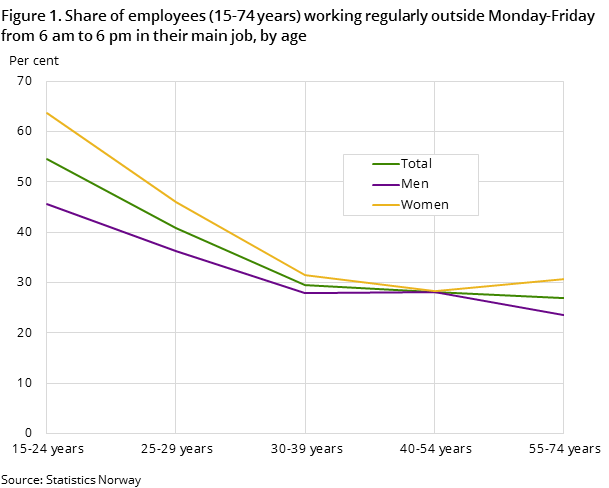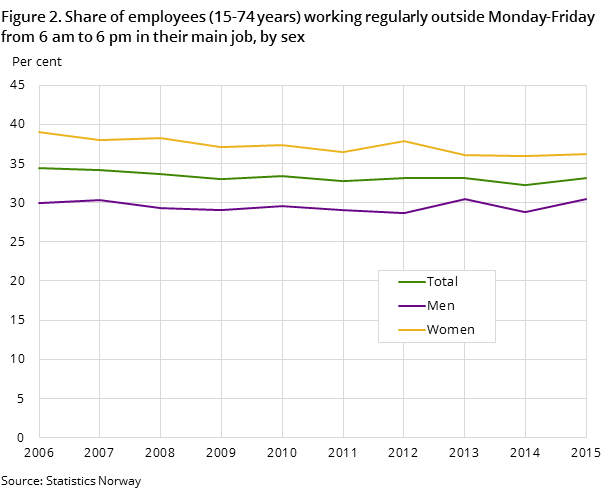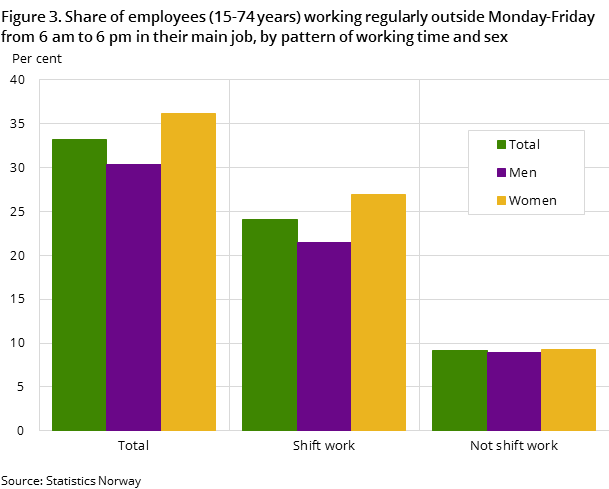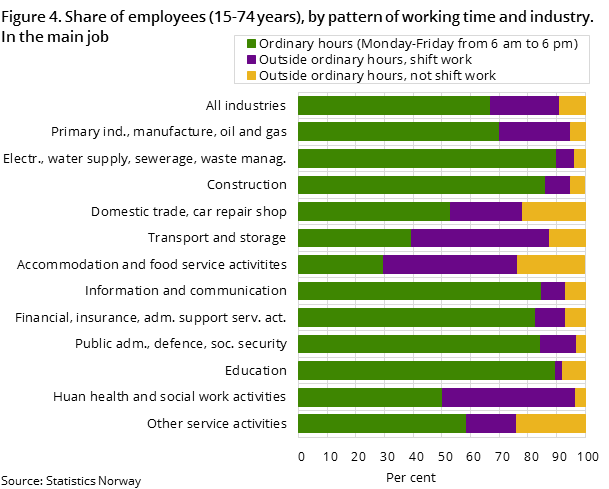Content
Published:
This is an archived release.
One in three work outside ordinary hours
In 2015, 33 per cent of the employees worked outside of Monday-Friday from 6 am to 6 pm. Women and youths are overrepresented among those with this kind of work. Many of the women have shift work in human health and social services activities. More than half of the under-25s work outside ordinary hours.
| 2012 | 2013 | 2014 | 2015 | |
|---|---|---|---|---|
| 1Regularly work outside Monday to Friday from 6 am to 6 pm. | ||||
| Both sexes | ||||
| Employees, total | 100.0 | 100.0 | 100.0 | 100.0 |
| Ordinary hours | 66.8 | 66.8 | 67.7 | 66.8 |
| Outside ordinary hours1 | 33.2 | 33.2 | 32.3 | 33.2 |
| Males | ||||
| Employees, total | 100.0 | 100.0 | 100.0 | 100.0 |
| Ordinary hours | 71.3 | 69.5 | 71.2 | 69.6 |
| Outside ordinary hours1 | 28.7 | 30.5 | 28.8 | 30.4 |
| Females | ||||
| Employees, total | 100.0 | 100.0 | 100.0 | 100.0 |
| Ordinary hours | 62.2 | 63.9 | 64.0 | 63.8 |
| Outside ordinary hours1 | 37.8 | 36.1 | 36.0 | 36.2 |




The share of employees working regularly outside ordinary hours in their main job has remained fairly stable at around 33 per cent during the period of 2009-2015. This is also true when we look at women and men separately. The same goes for youths, both with regard to the prevalence of work outside ordinary hours and to the working time schedules.
Most widespread among women
The share of employees working regularly outside ordinary hours is higher among women than among men. In 2015, 36 percent of female employees had this kind of work, compared with 30 per cent among men. The gender difference with regard to work outside ordinary hours is related to the fact that this kind of work is widespread in human health and social service activities – where women are highly overrepresented.
Common among youths
Work outside Monday-Friday from 6 am to 6 pm is more widespread among youths. Last year, 55 per cent of the employees aged 15-24 years worked regularly outside ordinary hours. The employees in this age often work on evening and/or on Saturdays. These are common working time schedules in domestic trade, where youths are strongly overrepresented. Working during these hours can be a practical way of combining work with school or studying, which is quite common in Norway.
Almost half of the women in human health and social service
Among the 432 000 female employees who worked regularly outside ordinary hours in 2015, 204 000 worked in human health and social services activities. Almost all of them had shift work. A total of 47 per cent of the employees in this industry had this kind of work. Shift work is almost as widespread among men as among women in this industry – but, as mentioned above, the great majority of the employees are women.
Many of the male employees working regularly outside ordinary hours do so within transport and storage and within manufacturing, quarrying or primary industries. In 2015, 36 per cent of the male employees with this kind of work was employed in one of these industries – a total of 140 000 persons.
Other industries with high shares of employees with this kind of work include accommodation and food service activities plus domestic trade. In 2015, 70 and 47 per cent of the employees in these two industries worked regularly outside ordinary hours, respectively. Domestic trade has many more employees than accommodation and food service activities: in 2015, there were 167 000 employees in domestic trade working regularly outside Monday-Friday from 6 am to 6 pm.
Often combined with part-time employment
Since the share working outside ordinary hours is high in some industries where part-time work is highly widespread, the total share of employees working outside ordinary hours is high among part-time employees. While the share of full-time employees working outside ordinary hours was 27 per cent in 2015, the corresponding share among part-time employees was 52 per cent. Both of these groups have relatively small disparities between women and men with regard to the frequency of working outside ordinary hours.
The statistics is published with Labour force survey.
Contact
-
Statistics Norway's Information Centre
E-mail: informasjon@ssb.no
tel.: (+47) 21 09 46 42
